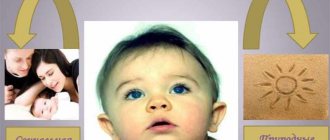Twilight disorder is a sudden and short-term loss of clarity of consciousness.
During this period, a person completely detaches himself from everything that surrounds him, or perceives the world distortedly. In the twilight state, habitual automatic actions are preserved, but delusions and hallucinations may appear, causing fear, melancholy, aggressive behavior, and rage. The attack passes as unexpectedly as it began. The individual has no memories of him, but sometimes they are fragmentary.
The twilight state of consciousness can last several minutes, days, and sometimes longer. It necessarily requires serious treatment by psychiatrists, since it poses a danger to both the person suffering from it and the people around him. Therefore, in the event of an attack, immediate hospitalization is necessary.
Stunned or lethargic
When faced with dazedness or inhibition, patients react poorly to their environment and speech, and they become indifferent to everything they see, hear and feel. If the disease worsens, simple stupor can turn into a coma
, that is, a complete “turn off” of consciousness. After exiting this state, the patient will remember absolutely nothing about what happened. The patient may fall into a coma if he has diabetes, kidney or liver failure, as well as some other diseases.
First aid for impaired consciousness
During a patient's attack, people around him must take urgent measures. If consciousness is completely lost, you need to try to bring the person back to his senses: give him a sniff of ammonia, put a napkin soaked in cold water on his head.
You should also immediately call an ambulance, even if the person who has lost consciousness has managed to recover from the fainting state.
In case of partial loss of consciousness, the provision of first aid may be complicated by the patient’s inappropriate behavior. If there is an incomplete loss of contact with reality, it is necessary to conduct a constant dialogue with the person so that a complete break with reality does not occur.
The patient should not be left alone with himself. However, others need to remember that in such a state a person may be susceptible to various kinds of hallucinations. He is capable of harming those he loves.
Delirium (hallucinations)
This syndrome means that the patient may experience various kinds of hallucinations - deceptions of the senses and perception. For example, a person may hear voices that are not there or see something that does not exist. At the same time, the patient is completely confident that everything is happening for real, and cannot distinguish reality from illusion. In this regard, the patient may experience severe behavioral deviations. They can manifest themselves in both positive and negative emotions, depending on the nature of the hallucinations.
For this reason, the patient can be dangerous both to himself and to others and society in the broad sense of the word. When “returning to reality,” the memory of hallucinations is preserved, but the memory of reality is most often not. This symptom often manifests itself in severe poisoning and infectious diseases.
Why does consciousness disappear?
The main causes of disturbances of consciousness include:
- psychological disorders without visible structural changes in the brain;
- disorders of cerebral circulation and electrical activity of the brain;
- infectious, metabolic and mental diseases;
- drug addiction, alcoholism, substance abuse;
- concussions and traumatic brain injuries.
Oneiric state (“waking dream”)
This symptom is associated with an influx of vivid hallucinations, most often with fabulous, impossible and even absurd content. The patient sees all these images and pictures, but, unlike delirium
, maintains the position of an external observer and does not actively participate in the “action”.
At the same time, the patient’s orientation in space and understanding of his own personality are disrupted. The memory of illusions is partially preserved. This symptom often occurs with congenital heart disease and certain types of infections.
Types of non-productive disorders of consciousness
Disturbances of consciousness can be productive or unproductive. With the latter, the activity of consciousness is reduced and there are no productive psychopathological symptoms, that is, deceptions of perception and delusions. There are three forms:
- stun
- sopor
- coma
Stun
When a person is deafened, the threshold for perception of external factors and internal impressions increases. Mental activity becomes poor, gradually fading away to an increasing extent. When stunned, only a very intense factor can attract a person's attention. A person does not answer questions immediately, and may not understand complex sentences. He usually answers after a long silence and in short phrases.
When a person is stunned, he is poorly oriented where he is and what places are located relative to the point where he is at the moment. There may be no orientation at all. A person is prone to indifference, akinesia, spontaneity and drowsiness. The voice is quiet, there is no modulation in it, there are no gestures, minimal facial expressions. Perseverations are recorded. The person does not remember that he was in a state of stun for some time. There are no fears.
Nullification
This condition is a mild degree of stunning. At the same time, the person seems uncollected or a little drunk. The meaning of speech (if addressed) is understood after some time. The answers may not correspond to the question, and the actions may also seem incorrect. There may be euphoria and fussiness. At times, for some moments, the person returns to normal consciousness.
An example of nullification: a person was injured in an accident, but does not understand this, and begins to actively remove doctors and try to help his loved ones who also suffered in this situation.
Somnolence
This condition is a form of unconsciousness. The person is very sleepy. If you don’t talk to him or make physical contact, he immediately falls soundly asleep. If you shake him and talk to him, he wakes up. But then he falls asleep again. Somnolence is noted upon recovery from an epileptic coma after seizures. After a seizure, you should not try to wake the person. This is not only difficult, but also dangerous, because it can cause an outbreak of aggression in the patient.
Stun
In its manifestations, stunning is similar to psychoorganic syndrome, but these are not synonyms. Main features:
- memory weakness
- impaired judgment
- aspontaneity
- torpidity
Stunning occurs in patients who are emerging from a coma. After stunning, a coma or a state of stupor can be recorded, which will be discussed in detail below.
Causes of stunning:
- swelling and swelling of brain tissue
- lack of oxygen reaching the brain
- acidosis due to intoxication, skull injury, etc.
Sopor
In this state, a person has only minimal signs of mental activity. If you call his name loudly, the person may turn around. If a person feels pain, he groans or tries to avoid the source of pain. Neurological disorders are also characteristic:
- decreased skin reflexes
- minimizing periosteal reflexes
- weakened tendon reflexes
- decreased muscle tone
Conjunctival and pupillary reflexes, as well as sensitivity, remain normal.
Coma
This condition is characterized by complete depression of mental activity. Main features:
- pelvic disorders
- pathological reflexes
- mydriasis with lack of pupillary response to light
- bulbar disorders
- lack of reflexes
- muscle atony
Transcendent coma is brain death, in which the functioning of internal organs is supported with the help of special devices. The condition is also known as supernumerary coma.
Amentive clouding of consciousness (amentia)
This is a condition in which the patient completely loses all ability to navigate both in space and in himself and his experiences. Everything he sees and feels is perceived in fragments and is not something whole. The processes of thinking and understanding what is happening are disrupted. of delirium occur
and
oneiric state
, causing fear.
The speech of such people can be thoughtless and incoherent. They are also characterized by a sharp change in activity, that is, excitement can suddenly give way to apathy
and helplessness. My mood also changes unusually often.
The amental state can be quite long - up to several months, and it is sometimes replaced by short periods of “enlightenment”. The dynamics of the disease completely depend on the physical condition of the patient, and this condition itself is characteristic of sepsis and cancer intoxication. In general, the very fact of an amental state, as a rule, indicates a serious illness in the patient.
Diagnostics
If all 4 of the above signs are present, this indicates darkness or disturbance of consciousness. This condition can affect people of any gender, age and race. Confirmation of the diagnosis does not require confirmation of amnesia or the end of acute psychosis. It is worth noting that consciousness can be only slightly impaired, then the person does not lose the ability to make specific judgments and does not get lost in place.
Sometimes the diagnosis is made retrospectively (that is, after the person has already experienced a violation of consciousness and restored it). Then you need to focus on the amnesia that was noted at that time, and on the remaining memories, which differ depending on the form of confusion. But the type of consciousness disorder is not always clearly defined due to mixed manifestations. Then, when forming a diagnosis, the form is not indicated, just about.
Twilight stupefaction
Twilight stupefaction is considered one of the most specific symptoms in medicine in general. It is characterized by complete loss of memory for the period of morning and evening (twilight). The patient's ability to navigate in space is severely impaired, severe hallucinations are possible, which the patient is afraid of, as well as incoherent speech and muttering. Fortunately, this symptom is quite rare and is not accompanied by a complete loss of consciousness (unlike, for example, epilepsy).
A characteristic feature of mental confusion in somatic diseases is that some of the memories are erased. The darknesses themselves are short-lived and proceed dynamically, often moving from one to another and to a normal state.
Signs of impaired consciousness
The first of the signs was named above. This is detachment; a person’s perception of the objects around him is “switched off” or it is very difficult. The surrounding world can be perceived as separate fragments or distorted, which is called a perceptual deception.
The next sign is a violation of rational cognition. A person does not understand what connection exists between objects, due to the fact that the ability to judge something is impaired, thinking is disorganized (in some cases it is completely absent).
A person does not orient himself in time, place, and does not understand who surrounds him. Sometimes, when consciousness is impaired, a person does not understand who he is. He may also believe that he is in a completely different place than he actually is. A person does not remember what happens, as well as his feelings at the moment of disturbance of consciousness. This is called congrade amnesia in the medical literature. In some cases, memories are incomplete or their sequence is disrupted. Sometimes memories seem like dreams.
But in some cases, after a disturbance of consciousness, the so-called Moli phenomenon is observed. A person can verbally reproduce everything that happened to him and feels quite active. Retarded amnesia may occur. This is forgetting that occurs at least 3-4 minutes or 2-3 hours after the person has regained consciousness.
Glossary of terms
In this section we have collected all the terms that you might encounter in this article. Gradually, we will collect from these explanations a real dictionary of a narcologist-psychiatrist. If some concepts remain unclear to you, leave your comments under the articles on our site. We will definitely help you figure it out.
Amentive clouding of consciousness (amentia)
– a form of clouding of consciousness, characterized by the patient’s confusion, incoherence of his speech and thinking, and disorder of movements. With amentia, complete clarity of consciousness does not occur at all, communication with the patient becomes impossible.
Hallucination
– images arising in the patient’s mind without external conditions. As a rule, hallucinations appear with the use of psychoactive substances (alcohol, drugs, many psychotropic medications), significant fatigue, as well as with mental disorders and neuralgia. Regular and prolonged hallucinations are a common occurrence in schizophrenia and are significant complications of its clinical picture.
Delirium
– a type of mental disorder associated with impaired consciousness (at first, clouding syndromes appear, then up to coma).
Accompanied by true hallucinations
(mainly visual), illusions, delusions,
senestopathies
and other symptoms. After recovering from delirium, the patient may forget both real events and hallucinations. A patient with delirium can be dangerous to himself and others.
True hallucinations
– a type of hallucination in which an imaginary object is located in objective space. They differ from illusions in that they do not occur in people who do not have mental disorders.
Comatose state (coma)
- a borderline state between life and death that threatens life. It is characterized by the patient’s loss of consciousness, lack of reactions to external stimuli or a significant decrease in such reactions, loss of reflexes, disturbances in breathing and pulse, and temperature regulation.
Oneiric state (oneiroid, schizophrenic delirium)
– mental pathology associated with a qualitative disturbance of consciousness (the so-called “oneiric disorientation”. The patient sees detailed pictures, experiences pseudo-hallucinatory sensations that are confused with reality. The patient is lost in time and space, may be confused in his own personality. Many include people around them in their fictional situation One of the characteristic signs of oneiroid is considered to be the transformation of the human “I” - for example, when a person begins to consider himself a tree or a bird.
Schizophrenic delirium
– the same as
oneiric state (oneiroid)
.
Causes and types
The causes of pathology are divided into two groups:
- organic - epilepsy, epileptiform syndrome, brain diseases, including tumors, damage to the medial temporal regions as a result of traumatic brain injury and a number of other conditions;
- functional - hysterical psychoses and narrowing of consciousness, affective states, unexpected situations with consequences in the form of severe psychological trauma.
There are twilight psychotic and non-psychotic disorders. The first include the following types, which have characteristic manifestations:
- Dysphoric twilight state of consciousness. A person acts in an orderly manner, he is self-absorbed, detached from the outside world, sad, does not respond to someone addressing him, or utters some stereotypical words that are not related to what the interlocutor is saying. The face is gloomy, even angry. Such patients can recognize familiar people and situations, but act inappropriately and are unable to critically evaluate what they are doing. Fleeting sensations of having a double, birth and death, etc. may arise.
- Delusional twilight disorder of consciousness. Delusional ideas are formed, and the patient’s behavior corresponds to their content. It seems to him that someone is pursuing him, wants to harm him, make him suffer, kill him. He is focused, behaves in an orderly manner, but normal communication with him is impossible. The patient’s actions are aimed at protecting against an imaginary threat dictated by delusion, most often antisocial. When the condition returns to normal, memories of the experience remain.
- Hallucinatory disorder is characterized by the presence of illusions and frightening visual and auditory hallucinations. Communication is impossible, since such a patient does not perceive reality and the appeal to him at all. He hums, pronounces or shouts individual words or phrases, most often inarticulate. As a reaction to terrible visions, aggression arises, the outbreaks of which result in very harsh actions performed with enormous force - beating, killing with bare hands or with the help of sharp objects.
A number of psychiatrists identify another type of psychotic twilight state of consciousness - oneiric. It is characterized by colorful fantastic or fairy-tale hallucinations, accompanied by catatonia - impaired motor functions, i.e. excitement or stupor.
Non-psychotic cloudings of consciousness include:
- Somniloquy - talking in your sleep.
- Somnambulism - sleepwalking, sleepwalking. Occurs in children and adolescents.
- Trances are long-term automatic actions. Most often, the patient leaves for another city.
- Outpatient automatisms are brief automatic actions. For example: a person leaves home, gets on public transport, and, upon waking up, finds himself incomprehensibly how and why in an unfamiliar place. The patient looks confused, thoughtful, there are no hallucinations or delusions. He does not remember at all what happened to him in a state of darkness.
- Genser's syndrome is a hysterical variant that occurs as a result of prolonged stress. The impetus for the development of the disorder is some kind of traumatic event, an unexpected exposure to unsafe, unusual conditions. The patient can only talk about these events, but he is not alienated from the world. The individual behaves like a clown, “falls into childhood” - he lisps, grimaces, and obviously answers simple questions absurdly. Knowing the purpose of things, he distorts their use, for example, he tries to pull gloves on his feet. Emotions suddenly change to the opposite. After an attack, the patient has fragmentary memories of what happened, which are restored after a good sleep.
The twilight state takes a person from reality to hallucinations. The latter replace a situation that was traumatic for him. Examples of darkness: amok - excitement, aggression and murder; the ritual of shamans - they introduce themselves into darkness and “infect” the participants in the action with it. An example can be given from literature - Lady Macbeth, the heroine of Shakespeare's tragedy of the same name, experiences a twilight episode in her sleep.
Treatment
If a person is in a coma, it is necessary to take preventive measures and eliminate disturbances in vital functions. It is necessary to ensure the supply of oxygen to the patient’s body. They perform artificial ventilation or use other methods. Next, you need to normalize blood circulation in the body. For this purpose, vasopressors or antihypertensive drugs can be used.
If there is a suspicion that impaired consciousness is caused by alcoholic beverages, treatment requires the administration of thiamine in a large dosage. Convulsions in cases of impaired consciousness are eliminated with the help of anticonvulsants. A patient in a coma is given glucose to prevent hypoglycemic brain damage. Next, tests are performed and the dosage is adjusted accordingly.
If the patient is in a state of psychomotor agitation, sedatives may be needed. If the balance of acids and alkalis is not in order, or there are water and electrolyte disturbances, these indicators need to be normalized. Body temperature also needs to be measured and brought back to normal. If the confusion is due to an infection or bacterial disease, antibiotics may be needed. In case of poisoning, detoxification therapy is necessary. After providing first aid, you need to take tests, interview relatives, and do research. The type and degree of impairment of consciousness is determined, and in connection with these data, effective therapy is prescribed.
Types of fainting
The classification of fainting is based on the causes of loss of consciousness. There are three main types of fainting:
- neurogenic;
- cardiogenic;
- hyperventilation.
Among neurogenic syncope, in turn, a distinction is made between vasodepressor and orthostatic. The first ones are the most common, usually occurring in fairly young patients in stuffy conditions, stress, fatigue, or lack of nutrients.
Orthostatic fainting occurs when there is a sudden change in body position (usually during a sudden rise or standing). It may also be caused by taking certain medications.
Cardiogenic loss of consciousness occurs when the heart rhythm is abnormal and can accompany a heart attack. Cardiogenic syncope accounts for up to a quarter of all cases of loss of consciousness, especially among the elderly population.
Hyperventilatory syncope occurs due to rapid breathing. This symptom is characteristic of panic attacks and anxiety attacks. Sometimes this condition is called a vegetative crisis.









